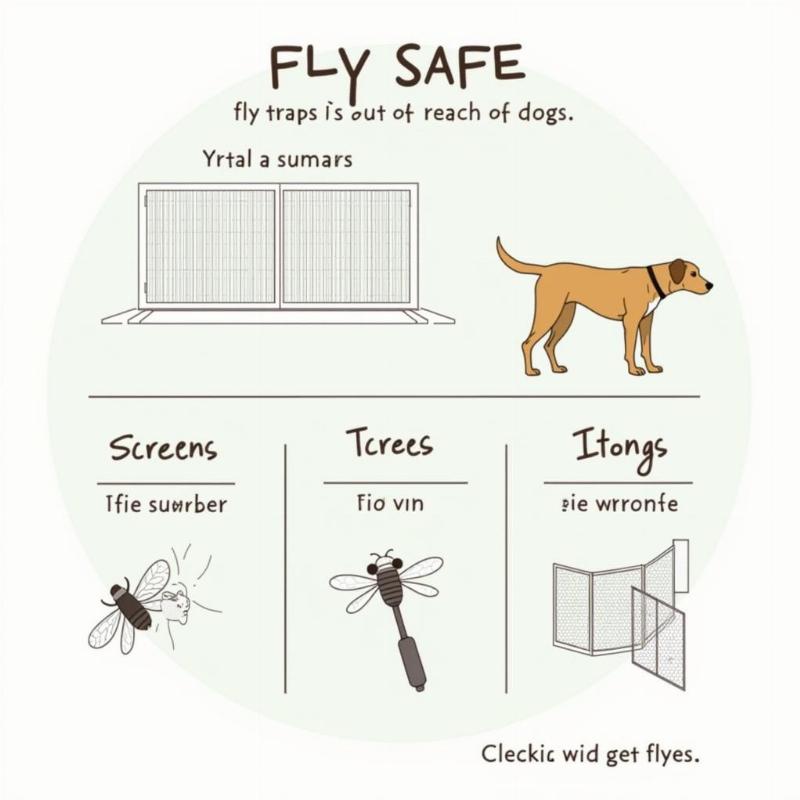Rescue fly traps, those sticky, sweet-smelling contraptions designed to lure and capture pesky flies, are a common sight in many American homes, especially during warmer months. But what if your curious canine companion decides to investigate? The question many dog owners have is: are rescue fly traps toxic to dogs? Let’s explore the potential risks and what you should do if your dog interacts with one.
Understanding the Risks of Rescue Fly Traps for Dogs
While rescue fly traps aren’t generally considered highly toxic, they can still pose a few risks to dogs, particularly if ingested. The sticky substance used to trap flies can cause gastrointestinal upset if your dog consumes a significant amount. This might lead to symptoms like vomiting, diarrhea, or loss of appetite. Furthermore, the plastic housing of the trap, if chewed and swallowed, could potentially cause a blockage, especially in smaller dogs.
The Sticky Situation: Ingestion Concerns
The primary concern with rescue fly traps is the sticky attractant. While the exact composition varies between brands, these attractants are typically made from sugary substances and sometimes contain additional fragrances. Large amounts of sugar can be disruptive to a dog’s digestive system. Moreover, some fragrances can irritate a dog’s stomach and cause discomfort.
Obstruction Alert: Plastic Perils
The plastic casing of the fly trap presents another potential hazard. If your dog chews and swallows pieces of the plastic, it could obstruct the digestive tract. This is a more serious concern, especially for puppies or small breed dogs. Signs of a blockage can include vomiting, lethargy, abdominal pain, and straining to defecate.
What to Do if Your Dog Encounters a Rescue Fly Trap
If you suspect your dog has ingested any part of a rescue fly trap, it’s essential to contact your veterinarian immediately. They can provide guidance based on your dog’s size, breed, and the amount ingested. Do not induce vomiting unless instructed by your veterinarian.
Monitoring Your Pup: Signs to Watch For
Even if your dog seems fine after interacting with a fly trap, it’s crucial to monitor them closely for any changes in behavior or appetite. Look out for signs of vomiting, diarrhea, lethargy, abdominal pain, or difficulty defecating. If any of these symptoms appear, seek veterinary care immediately.
Preventing Fly Trap Incidents: Keeping Your Dog Safe
The best way to protect your dog from the potential risks of rescue fly traps is prevention. Place traps in areas where your dog cannot reach them. Consider using alternative fly control methods, such as screens on windows and doors, or fly swatters in areas accessible to your dog.  Preventative measures for fly traps and dogs
Preventative measures for fly traps and dogs
Conclusion: Prioritizing Your Dog’s Safety
While rescue fly traps are a convenient way to control flies, they can pose risks to our canine companions. By understanding these risks and taking preventative measures, you can ensure your furry friend stays safe and healthy this summer. Remember, if your dog does ingest any part of a fly trap, immediate veterinary attention is crucial. Keep your home safe and your dog happy by being mindful of these potential hazards.
FAQ
- Are all fly traps toxic to dogs? While not all are highly toxic, all can present some level of risk, especially if ingested.
- What should I do if my dog eats the sticky stuff from a fly trap? Contact your veterinarian immediately for advice.
- Can fly traps cause a blockage in my dog? Yes, if the plastic casing is ingested, it can potentially cause a blockage.
- How can I prevent my dog from getting into fly traps? Place traps out of reach and consider alternative fly control methods.
- What are the signs of a blockage in a dog? Vomiting, lethargy, abdominal pain, and difficulty defecating.
- Are there any safe fly traps for homes with dogs? The safest approach is to use fly control methods that are completely inaccessible to your dog.
- What should I tell my veterinarian if my dog eats a fly trap? Tell them the brand of fly trap, the approximate amount ingested, and any symptoms your dog is exhibiting.
is rescue fly trap toxic to dogs
spider spray safe for dogs
chewing deterrent spray for dogs
are rescue fly traps poisonous to dogs
Beautdogs.us is your premier online resource for all things dog-related in the US. From breed information and expert grooming tips to product reviews and the latest in canine health, we’re your trusted source for comprehensive dog care. Whether you’re a seasoned dog owner or just starting your journey with a furry friend, Beautdogs.us is here to help you navigate the wonderful world of dog ownership. Contact us today for all your dog-related needs! Email: [email protected], Phone: +1 501-555-7529.